Glan-Taylor Calcite Polarizers
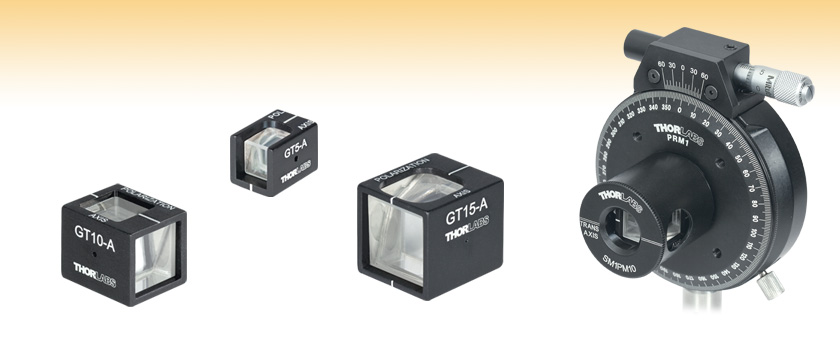
- Extinction Ratio: 100 000:1
- Polarizing Prisms Utilize Two Air-Spaced Calcite Prisms
- 350 nm - 2.3 µm Wavelength Range
GT10-A
GT5-A
GT15-A
Application Idea
GT10-A Polarizer and SM1PM10
Mount on a PRM1 Rotation Mount

Please Wait
Glan-Taylor Calcite Polarizers Divert Ordinary Rays, Leaving Very Highly Polarized Extraordinary Rays (Aligned with the "Polarization Axis" Mark on the Housing) Passing Through the Polarizer
Features
- Extinction Ratio for Output Beam: 100 000:1 (See Diagram Below for Details)
- Glan-Taylor Design (Air-Spaced Birefringent Crystal Prisms)
- Fabricated from Laser-Quality Natural Calcite (Low Scatter)
- Wavefront Distortion ≤λ/4 Over Clear Aperture (Excluding Side Ports)
- 20-10 Scratch-Dig Surface Quality on Input and Exit Faces (80-50 on Side Ports)
- 350 nm - 2.3 μm Wavelength Range (Uncoated)
- Available with Broadband AR Coatings
Our Glan-Taylor Polarizers produce extremely pure linear polarization with an extinction ratio greater than 100,000:1 and are meant for use with laser beams in the 350 nm - 2.3 μm wavelength range. A significant amount of reflected light escapes the polarizers through the side port, including all of the ordinary ray and some of the extraordinary ray. As such, the escape beam is not fully polarized, and only the transmitted extraordinary ray should be used for applications that require a high-quality, polarized beam.
The input and output faces of these polarizers are polished to a laser quality 20-10 scratch-dig surface finish to minimize scattering of the transmitted extraordinary polarization component of the incident laser beam or light field. The ordinary polarization component is reflected and exits the polarizer at a 68° angle (wavelength dependent) through one of the two uncoated side ports, which are provided to allow bidirectional use of the polarizer. The escape ray is not fully polarized and the side escape ports have a lower surface quality of 80-50 scratch-dig.
| Click on the red Document icon next to the item numbers below to access the Zemax file download. Our entire Zemax Catalog is also available. |
Thorlabs' Glan-Taylor Calcite Polarizers are available in black anodized housings with 5 mm, 10 mm, or 15 mm clear apertures. They are offered uncoated or with standard broadband antireflection coatings for 350 - 700 nm, 650 - 1050 nm, or 1050 - 1700 nm (see the Graphs tab above for more information).
For high power applications, Thorlabs offers Glan-Laser Polarizers, which are fabricated from lower scatter natural calcite. Our pre-mounted polarizers can be mounted inside our Polarizing Prism Mounts for compatibility with our SM05 (0.535"-40) or SM1 (1.035"-40) threads. The SM05PM5 provides SM05 compatibility for pre-mounted polarizers with Ø5 mm clear apertures, while the SM1PM10 and SM1PM15 provide SM1 compatibility for polarizers with Ø10 mm or Ø15 mm clear apertures, respectively.
Calcite is a natural material and transmittance of light near 350 nm is typically around 75% (see Graphs tab). For applications in the UV, we suggest using α-BBO polarizers as they offer superior UV transmittance. It is not recommended to use these polarizers for input beams with wavelengths greater than 2.3 µm, as calcite has different absorption coefficients for the ordinary and extrarodinary rays that diverge past this point.
| Item # Prefix | GT5 | GT10 | GT15 |
|---|---|---|---|
| Extinction Ratioa | 100 000:1 | ||
| Substrate | Laser Quality Natural Calciteb (Low Scatter) | ||
| Design | High Laser Damage Threshold Air-Spaced Design | ||
| Wavefront Distortion | ≤ λ/4 Over Clear Aperture | ||
| Transmission Range | 0.35 - 2.3 µm | ||
| Surface Quality (Input/Output Faces) |
20-10 Scratch-Dig | ||
| Surface Quality (Side Ports) |
80-50 Scratch-Dig | ||
| Clear Aperturec | 5.0 mm x 5.0 mm | 10.0 mm x 10.0 mm | 15.0 mm x 15.0 mm |
| Prism Dimensions (W x L) |
6.5 mm x 7.5 mm | 12.2 mm x 13.7 mm | 17.2 mm x 21.6 mm |
| Coating Specifications | ||
|---|---|---|
| Coating Designationd | Reflectancee (Avg.) |
Damage Thresholdc |
| Uncoated (350 nm - 2.3 µm) | N/A | 20 J/cm2 (1064 nm, 10 ns, 10 Hz, Ø0.433 mm) |
| -A (350 - 700 nm) | <1% | 5 J/cm2 (532 nm, 10 ns, 10 Hz, Ø0.750 mm) |
| -B (650 - 1050 nm) | <1% | 5 J/cm2 (810 nm, 10 ns, 10 Hz, Ø0.155 mm) |
| -C (1050 - 1700 nm) | <1% | 5 J/cm2 (1542 nm, 10 ns, 10 Hz, Ø0.177 mm) |
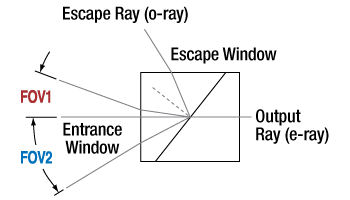
Field of View Angle Orientation
A significant amount of scattered unpolarized light escapes the polarizers. As a result, the escape ray (o-ray) is not purely polarized and should not be used for polarization dependent applications. The output ray has a very pure polarization with an extinction ratio of 100 000:1.
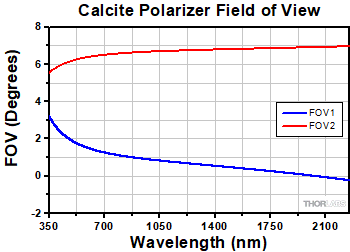
Click to Enlarge
Raw Data
Note: Since calcite is a soft material, care must be taken when cleaning. The coated faces of the polarizer can be gently cleaned with solvent and air. The escape faces (uncoated and perpendicular to the input / exit faces) are extremely delicate and can be damaged very easily. Do not touch these faces if possible. Cleaning should be light and at a glancing angle. If these surfaces must be wiped, use only solvent-moistened cotton or untreated facial tissues.
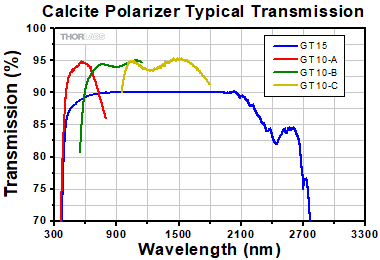
Click to Enlarge
Click Here for Raw Data
The transmission graph above shows the typical transmission of calcite polarizers, including any internal losses. The transmission is valid for linearly polarized light aligned with the mark on the housing of the polarizer. Calcite is a natural material, and thus transmission can vary significantly, particularly in the UV and IR. Consequently, the performance data shown above may vary from lot to lot and is not guaranteed.
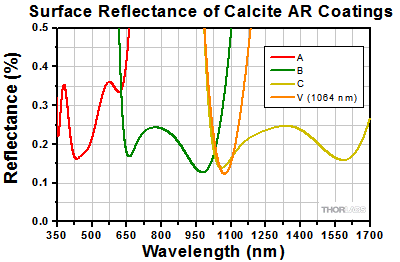
Click to Enlarge
Click Here for Raw Data
The AR coating graph above shows the typical surface reflections associated with each of the AR coatings offered on our Glan-Laser Calcite Polarizers. Please note that this data represents the performance of the surface coating and does not include any internal losses.
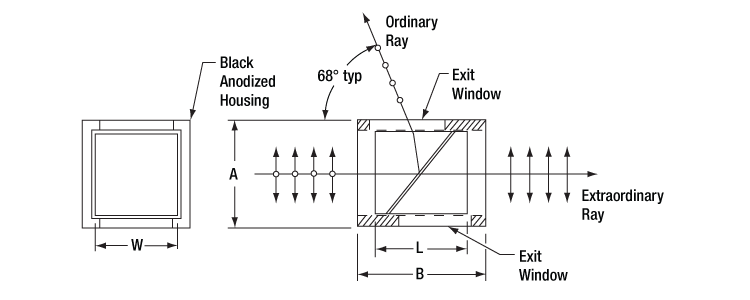
Glan Taylor Specifications
| Item # | GT5 | GT10 | GT15 |
|---|---|---|---|
| W | 6.5 mm | 12 mm | 17 mm |
| La | 7.5 mm | 13.7 mm | 17.3 mm |
| A | 9.5 mm | 16 mm | 22.3 mm |
| B | 12.7 mm | 19.2 mm | 25.4 mm |
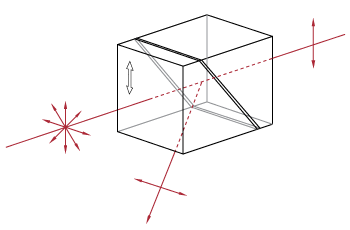
General
Our calcite polarizers are all based on high-grade, birefringent calcite crystals. Due to the birefringent nature of calcite, waves polarized in the direction of the optical axis propagate with a different index of refraction than waves polarized orthogonally to the optical axis. In our Glan-Taylor polarizers, this birefringence causes the ordinary polarization component of an incident beam to undergo total internal reflection at an internal glass-to-air interface. The light transmitted through the polarizer then consists of only the remaining extraordinary polarization component. While these transmitted extraordinary rays are highly polarized, the reflected ordinary rays are only partially polarized.
Our Glan-Laser and Glan-Taylor polarizers are designed as polarizer elements that remove the reflected ordinary polarization component of a beam. These polarizers are built out of two prisms, as shown in the drawing to the right. They are only designed to work with well collimated light beams; converging and diverging input beams will not exhibit proper polarization and incidence angle at the internal interface. Since calcite is a soft crystal that is easily damaged, almost all of our calcite polarizers are offered in metal housings. With convenient threadings and adapters, these housings can easily be mounted into our opto-mechanical products.
Field of View
Calcite polarizers feature a field of view (FOV) that varies with both wavelength and entrance orientation. The FOV of these prisms must be considered during alignment and collimation procedures.
As seen in the drawing and graph below and to the right, the side of the polarizer with the escape window has an FOV that decreases as the wavelength increases (FOV 1). The opposite side has an FOV that increases as the wavelength increases (FOV 2).

Transmission
Thorlabs uses only the highest quality natural calcite in our polarizing prisms. Typical transmission curves for these polarizers may be found on the Graphs tab. Because calcite is a naturally occuring material, variations in the crystal affect the transmission curve and the damage threshold rating. Variations in the calcite transmission curve are typically limited to wavelengths > 2 μm, making calcite an excellent material to use in the visible and NIR.
| Thorlabs' Calcite Polarizers | ||
|---|---|---|
| Glan-Laser Polarizers | Glan-Taylor Polarizers | Wollaston Polarizers |
| Glan-Thompson Polarizers Mounted or Unmounted |
Double Glan-Taylor Polarizer | Beam Displacers |
| Damage Threshold Specifications | |
|---|---|
| Coating Designation (Item # Suffix) |
Damage Threshold |
| (Uncoated) | 20 J/cm2 (1064 nm, 10 ns, 10 Hz, Ø0.433 mm) |
| -A | 5 J/cm2 (532 nm, 10 ns, 10 Hz, Ø0.750mm) |
| -B | 5 J/cm2 (810 nm, 10 ns, 10 Hz, Ø0.155 mm) |
| -C | 5 J/cm2 (1542 nm, 10 ns, 10 Hz, Ø0.177 mm) |
Damage Threshold Data for Thorlabs' Glan-Taylor Calcite Polarizers
The specifications to the right are measured data for Thorlabs' Glan-Taylor calcite polarizers. Damage threshold specifications are constant for a given coating type, regardless of the size of the polarizer.
Care should be taken to ensure that the polarizer's clear aperture is large enough for your beam, and that the polarizer is well aligned. While each polarizer is air-spaced within the clear aperture, the prisms composing the polarizer are separated by an epoxied photo-etched spacer that is not designed to withstand high laser powers. Using these parts outside of the clear aperture can result in catastrophic damage and failure.
Laser Induced Damage Threshold Tutorial
The following is a general overview of how laser induced damage thresholds are measured and how the values may be utilized in determining the appropriateness of an optic for a given application. When choosing optics, it is important to understand the Laser Induced Damage Threshold (LIDT) of the optics being used. The LIDT for an optic greatly depends on the type of laser you are using. Continuous wave (CW) lasers typically cause damage from thermal effects (absorption either in the coating or in the substrate). Pulsed lasers, on the other hand, often strip electrons from the lattice structure of an optic before causing thermal damage. Note that the guideline presented here assumes room temperature operation and optics in new condition (i.e., within scratch-dig spec, surface free of contamination, etc.). Because dust or other particles on the surface of an optic can cause damage at lower thresholds, we recommend keeping surfaces clean and free of debris. For more information on cleaning optics, please see our Optics Cleaning tutorial.
Testing Method
Thorlabs' LIDT testing is done in compliance with ISO/DIS 11254 and ISO 21254 specifications.
First, a low-power/energy beam is directed to the optic under test. The optic is exposed in 10 locations to this laser beam for 30 seconds (CW) or for a number of pulses (pulse repetition frequency specified). After exposure, the optic is examined by a microscope (~100X magnification) for any visible damage. The number of locations that are damaged at a particular power/energy level is recorded. Next, the power/energy is either increased or decreased and the optic is exposed at 10 new locations. This process is repeated until damage is observed. The damage threshold is then assigned to be the highest power/energy that the optic can withstand without causing damage. A histogram such as that below represents the testing of one BB1-E02 mirror.

The photograph above is a protected aluminum-coated mirror after LIDT testing. In this particular test, it handled 0.43 J/cm2 (1064 nm, 10 ns pulse, 10 Hz, Ø1.000 mm) before damage.

| Example Test Data | |||
|---|---|---|---|
| Fluence | # of Tested Locations | Locations with Damage | Locations Without Damage |
| 1.50 J/cm2 | 10 | 0 | 10 |
| 1.75 J/cm2 | 10 | 0 | 10 |
| 2.00 J/cm2 | 10 | 0 | 10 |
| 2.25 J/cm2 | 10 | 1 | 9 |
| 3.00 J/cm2 | 10 | 1 | 9 |
| 5.00 J/cm2 | 10 | 9 | 1 |
According to the test, the damage threshold of the mirror was 2.00 J/cm2 (532 nm, 10 ns pulse, 10 Hz, Ø0.803 mm). Please keep in mind that these tests are performed on clean optics, as dirt and contamination can significantly lower the damage threshold of a component. While the test results are only representative of one coating run, Thorlabs specifies damage threshold values that account for coating variances.
Continuous Wave and Long-Pulse Lasers
When an optic is damaged by a continuous wave (CW) laser, it is usually due to the melting of the surface as a result of absorbing the laser's energy or damage to the optical coating (antireflection) [1]. Pulsed lasers with pulse lengths longer than 1 µs can be treated as CW lasers for LIDT discussions.
When pulse lengths are between 1 ns and 1 µs, laser-induced damage can occur either because of absorption or a dielectric breakdown (therefore, a user must check both CW and pulsed LIDT). Absorption is either due to an intrinsic property of the optic or due to surface irregularities; thus LIDT values are only valid for optics meeting or exceeding the surface quality specifications given by a manufacturer. While many optics can handle high power CW lasers, cemented (e.g., achromatic doublets) or highly absorptive (e.g., ND filters) optics tend to have lower CW damage thresholds. These lower thresholds are due to absorption or scattering in the cement or metal coating.

LIDT in linear power density vs. pulse length and spot size. For long pulses to CW, linear power density becomes a constant with spot size. This graph was obtained from [1].

Pulsed lasers with high pulse repetition frequencies (PRF) may behave similarly to CW beams. Unfortunately, this is highly dependent on factors such as absorption and thermal diffusivity, so there is no reliable method for determining when a high PRF laser will damage an optic due to thermal effects. For beams with a high PRF both the average and peak powers must be compared to the equivalent CW power. Additionally, for highly transparent materials, there is little to no drop in the LIDT with increasing PRF.
In order to use the specified CW damage threshold of an optic, it is necessary to know the following:
- Wavelength of your laser
- Beam diameter of your beam (1/e2)
- Approximate intensity profile of your beam (e.g., Gaussian)
- Linear power density of your beam (total power divided by 1/e2 beam diameter)
Thorlabs expresses LIDT for CW lasers as a linear power density measured in W/cm. In this regime, the LIDT given as a linear power density can be applied to any beam diameter; one does not need to compute an adjusted LIDT to adjust for changes in spot size, as demonstrated by the graph to the right. Average linear power density can be calculated using the equation below.

The calculation above assumes a uniform beam intensity profile. You must now consider hotspots in the beam or other non-uniform intensity profiles and roughly calculate a maximum power density. For reference, a Gaussian beam typically has a maximum power density that is twice that of the uniform beam (see lower right).
Now compare the maximum power density to that which is specified as the LIDT for the optic. If the optic was tested at a wavelength other than your operating wavelength, the damage threshold must be scaled appropriately. A good rule of thumb is that the damage threshold has a linear relationship with wavelength such that as you move to shorter wavelengths, the damage threshold decreases (i.e., a LIDT of 10 W/cm at 1310 nm scales to 5 W/cm at 655 nm):

While this rule of thumb provides a general trend, it is not a quantitative analysis of LIDT vs wavelength. In CW applications, for instance, damage scales more strongly with absorption in the coating and substrate, which does not necessarily scale well with wavelength. While the above procedure provides a good rule of thumb for LIDT values, please contact Tech Support if your wavelength is different from the specified LIDT wavelength. If your power density is less than the adjusted LIDT of the optic, then the optic should work for your application.
Please note that we have a buffer built in between the specified damage thresholds online and the tests which we have done, which accommodates variation between batches. Upon request, we can provide individual test information and a testing certificate. The damage analysis will be carried out on a similar optic (customer's optic will not be damaged). Testing may result in additional costs or lead times. Contact Tech Support for more information.
Pulsed Lasers
As previously stated, pulsed lasers typically induce a different type of damage to the optic than CW lasers. Pulsed lasers often do not heat the optic enough to damage it; instead, pulsed lasers produce strong electric fields capable of inducing dielectric breakdown in the material. Unfortunately, it can be very difficult to compare the LIDT specification of an optic to your laser. There are multiple regimes in which a pulsed laser can damage an optic and this is based on the laser's pulse length. The highlighted columns in the table below outline the relevant pulse lengths for our specified LIDT values.
Pulses shorter than 10-9 s cannot be compared to our specified LIDT values with much reliability. In this ultra-short-pulse regime various mechanics, such as multiphoton-avalanche ionization, take over as the predominate damage mechanism [2]. In contrast, pulses between 10-7 s and 10-4 s may cause damage to an optic either because of dielectric breakdown or thermal effects. This means that both CW and pulsed damage thresholds must be compared to the laser beam to determine whether the optic is suitable for your application.
| Pulse Duration | t < 10-9 s | 10-9 < t < 10-7 s | 10-7 < t < 10-4 s | t > 10-4 s |
|---|---|---|---|---|
| Damage Mechanism | Avalanche Ionization | Dielectric Breakdown | Dielectric Breakdown or Thermal | Thermal |
| Relevant Damage Specification | No Comparison (See Above) | Pulsed | Pulsed and CW | CW |
When comparing an LIDT specified for a pulsed laser to your laser, it is essential to know the following:

LIDT in energy density vs. pulse length and spot size. For short pulses, energy density becomes a constant with spot size. This graph was obtained from [1].
- Wavelength of your laser
- Energy density of your beam (total energy divided by 1/e2 area)
- Pulse length of your laser
- Pulse repetition frequency (prf) of your laser
- Beam diameter of your laser (1/e2 )
- Approximate intensity profile of your beam (e.g., Gaussian)
The energy density of your beam should be calculated in terms of J/cm2. The graph to the right shows why expressing the LIDT as an energy density provides the best metric for short pulse sources. In this regime, the LIDT given as an energy density can be applied to any beam diameter; one does not need to compute an adjusted LIDT to adjust for changes in spot size. This calculation assumes a uniform beam intensity profile. You must now adjust this energy density to account for hotspots or other nonuniform intensity profiles and roughly calculate a maximum energy density. For reference a Gaussian beam typically has a maximum energy density that is twice that of the 1/e2 beam.
Now compare the maximum energy density to that which is specified as the LIDT for the optic. If the optic was tested at a wavelength other than your operating wavelength, the damage threshold must be scaled appropriately [3]. A good rule of thumb is that the damage threshold has an inverse square root relationship with wavelength such that as you move to shorter wavelengths, the damage threshold decreases (i.e., a LIDT of 1 J/cm2 at 1064 nm scales to 0.7 J/cm2 at 532 nm):

You now have a wavelength-adjusted energy density, which you will use in the following step.
Beam diameter is also important to know when comparing damage thresholds. While the LIDT, when expressed in units of J/cm², scales independently of spot size; large beam sizes are more likely to illuminate a larger number of defects which can lead to greater variances in the LIDT [4]. For data presented here, a <1 mm beam size was used to measure the LIDT. For beams sizes greater than 5 mm, the LIDT (J/cm2) will not scale independently of beam diameter due to the larger size beam exposing more defects.
The pulse length must now be compensated for. The longer the pulse duration, the more energy the optic can handle. For pulse widths between 1 - 100 ns, an approximation is as follows:

Use this formula to calculate the Adjusted LIDT for an optic based on your pulse length. If your maximum energy density is less than this adjusted LIDT maximum energy density, then the optic should be suitable for your application. Keep in mind that this calculation is only used for pulses between 10-9 s and 10-7 s. For pulses between 10-7 s and 10-4 s, the CW LIDT must also be checked before deeming the optic appropriate for your application.
Please note that we have a buffer built in between the specified damage thresholds online and the tests which we have done, which accommodates variation between batches. Upon request, we can provide individual test information and a testing certificate. Contact Tech Support for more information.
[1] R. M. Wood, Optics and Laser Tech. 29, 517 (1998).
[2] Roger M. Wood, Laser-Induced Damage of Optical Materials (Institute of Physics Publishing, Philadelphia, PA, 2003).
[3] C. W. Carr et al., Phys. Rev. Lett. 91, 127402 (2003).
[4] N. Bloembergen, Appl. Opt. 12, 661 (1973).
| Posted Comments: | |
user
(posted 2023-09-28 06:56:21.2) Do you have a rough estimate for the length of the internal air gap? I am trying to estimate possible wavelength-dependent offsets that may occur in beam propagation. J D
(posted 2023-09-20 13:42:33.097) What is the angle of the plane between the two prisms with respect to the optical axis? Is it the Brewsters angle for ordinary refractive index or extraordinary refractive index? And how do you define the FOV in the graphs for that product? cdolbashian
(posted 2023-10-02 04:10:45.0) Thank you for reaching out to us with this inquiry. The angle which these two crystals are mated is close to 38° and as such the Brewster's angle is set for the extraordinary index of refraction. In the specs tab, we have a helpful visual aid which references the FOV1 and FOV2 shown in the graphs. Additionally, I have reached out to you directly to discuss this further and share some additional resources. user
(posted 2022-07-07 03:13:06.22) Is Glan-Taylor polariser same as a nicol prism? If not, then what is the main difference between them in terms of working principle? cdolbashian
(posted 2022-07-19 02:49:02.0) Thank you for reaching out with this inquiry. The main difference is the working mechanism: Nicol prisms have a 68 degree incident angle on the incoming and outgoing faces and a specific adhesive used to induce total internal reflection at the interface between cut edges. Due to this fact the entrance angle of the Nicol prism AOI is important as well as the fact that the exit beam will be laterally displaced due to the 68 degree cut.
Comparatively, The Glan-Taylor connects the two triangular halves of the prism, with an air gap and uses the Brewsters angle to transmit/reflect light and subsequently polarize it. The downside of this is that the reflected beam does not have a perfectly clean polarization state as the transmitted beam would. user
(posted 2015-07-15 16:20:10.987) Hello,
Is it normal to experience a lateral displacement of the beam from the original optical axis after the GL polarizer is inserted? besembeson
(posted 2015-08-18 01:32:07.0) Response from Bweh at Thorlabs USA: It actually depends. There is a very tiny air gap between the prisms. Can you say how much displacement you observe? You can contact us at techsupport@thorlabs.com for follow-up ecerda
(posted 2013-11-20 22:24:43.41) I did not understand how to get the linear power density (W/cm) from the tutorial, and also the LIDTs are specified only in J/cm2 (for pulsed lasers). I have a 2kW CW laser @810nm with a Gaussian spot of ~1mm diameter. I wonder if I can use the GT5 (or the high power version) with it or if you would recommend other polarizer. I want to use it along with a lambda/2 plate as attenuator. Thank you very much. jlow
(posted 2013-12-17 01:45:22.0) Response from Jeremy at Thorlabs: We only have test data for the damage threshold for pulsed laser. For CW, the damage threshold is estimated to be on the order of a few kW/cm. Using 2kW and Ø1mm, the linear power density would be 20kW/cm (assuming uniform beam), which is a whole order magnitude higher. I will contact you to discuss about this further. bougas
(posted 2013-10-02 14:29:28.507) Hello, I want to make a high extinction ratio balanced polarimeter at 1315nm and I need high polarization purity for both output beams.
Would you recommend using your Glan-Taylor as the polarizing beam splitter in such a setup?
Is there a reason why you do not recommend these as polarizing beam splitters? tcohen
(posted 2013-10-03 12:18:00.0) Response from Tim at Thorlabs: The specified extinction ratio is only for the transmitted ray. The escape ray is not purely polarized and therefore may not be suitable for an application in which the purity of both beams are required. We will contact you to discuss this further. Mathias.Helsen
(posted 2013-02-06 11:06:08.373) Could you tell me what the CW damage level of this (GT10-A) polarizer is at around 633-655nm? cdaly
(posted 2013-02-14 15:56:00.0) Response from Chris at Thorlabs: Thank you for using our web feedback. We feel the Glan-Taylor polarizers will be able to handle powers up to 250 W/cm^2 at this wavelength. jlow
(posted 2012-09-28 09:52:00.0) Response from Jeremy at Thorlabs: Yes, these can be purchased unmounted. We will get in contact with you regarding a quote. alsturl
(posted 2012-09-27 16:49:27.0) Can these be purchased unmounted? Thanks. Tyler
(posted 2008-09-23 09:42:59.0) A response from Tyler at Thorlabs to gschuele: The internal transmission of calcite is ~55% at 355 nm. Thank you for posting your question, we will soon add a plot to our web presentation showing the internal transmission of calcite as a function of wavelength. gschuele
(posted 2008-09-15 17:53:22.0) What is the transmission with the A-AR coating at 355nm for the polarizes. Basically it is the question about the internal absorption of calcite at 355nm.
THNX, Georg |
Polarizer Selection Guide
Thorlabs offers a diverse range of polarizers, including wire grid, film, calcite, alpha-BBO, rutile, and beamsplitting polarizers. Collectively, our line of wire grid polarizers offers coverage from the visible range to the beginning of the Far-IR range. Our nanoparticle linear film polarizers provide extinction ratios as high as 100 000:1. Alternatively, our other film polarizers offer an affordable solution for polarizing light from the visible to the Near-IR. Next, our beamsplitting polarizers allow for use of the reflected beam, as well as the more completely polarized transmitted beam. Finally, our alpha-BBO (UV), calcite (visible to Near-IR), rutile (Near-IR to Mid-IR), and yttrium orthovanadate (YVO4) (Near-IR to Mid-IR) polarizers each offer an exceptional extinction ratio of 100 000:1 within their respective wavelength ranges.
To explore the available types, wavelength ranges, extinction ratios, transmission, and available sizes for each polarizer category, click More [+] in the appropriate row below.
| Wire Grid Polarizers |
|---|
| Film Polarizers |
|---|
| Beamsplitting Polarizers |
|---|
| alpha-BBO Polarizers |
|---|
| Calcite Polarizers |
|---|
| Quartz Polarizers |
|---|
| Magnesium Fluoride Polarizers |
|---|
| Yttrium Orthovanadate (YVO4) Polarizers |
|---|
| Rutile Polarizers |
|---|

*The AR coating is designed for 350 - 700 nm. However, calcite's transmittance is diminished in the UV (see Graphs tab). Thorlabs recommends using a-BBO polarizers for UV applications.
 Products Home
Products Home











 Glan-Taylor Polarizers
Glan-Taylor Polarizers